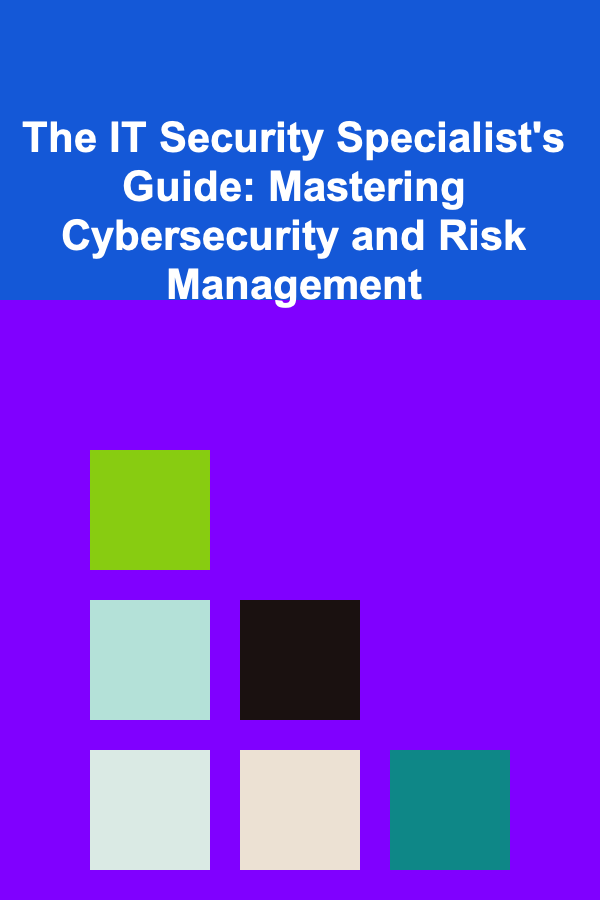
The IT Security Specialist's Guide: Mastering Cybersecurity and Risk Management
ebook include PDF & Audio bundle (Micro Guide)
$12.99$6.99
Limited Time Offer! Order within the next:

In today's digital age, organizations of all sizes are heavily reliant on information technology. As a result, the security of IT systems and data has never been more critical. With the rise in cyber threats, including hacking, data breaches, ransomware attacks, and other forms of malicious activities, IT security specialists are on the front lines of protecting sensitive information and ensuring the safety of business operations. This comprehensive guide offers actionable insights into mastering cybersecurity and risk management, crucial for IT security specialists.
Understanding Cybersecurity and Its Importance
Cybersecurity encompasses the practices, technologies, and processes designed to protect systems, networks, and data from cyber threats, such as unauthorized access, attacks, or damage. For an IT security specialist, the primary goal is to safeguard organizational data, ensure the confidentiality, integrity, and availability (CIA triad) of critical information, and protect users from cyber threats.
Why Cybersecurity Matters:
- Preventing Financial Loss: Cyber-attacks can lead to significant financial losses. Data breaches and ransomware attacks alone can cost companies millions in remediation, fines, and loss of business.
- Maintaining Customer Trust: Organizations that suffer data breaches risk losing customer trust, which can have long-lasting effects on their reputation and customer loyalty.
- Ensuring Legal Compliance: Organizations must adhere to numerous regulations, such as GDPR, HIPAA, and others, that mandate the protection of sensitive data. Failure to comply can lead to heavy fines and legal actions.
- Safeguarding Intellectual Property: Many businesses possess valuable intellectual property, and cyberattacks can result in loss, theft, or damage to this crucial asset.
Actionable Tip: Always understand the unique needs of your organization or clients in terms of data protection. Tailor your cybersecurity strategy to align with the type of data you handle, the potential threats, and the regulatory environment you're operating in.
Core Principles of IT Security: The CIA Triad
At the heart of IT security is the CIA Triad, which stands for Confidentiality , Integrity , and Availability. These three pillars guide all cybersecurity efforts and are fundamental for any IT security specialist.
Confidentiality
Confidentiality ensures that sensitive information is accessible only to those who are authorized to access it. This includes encryption, access controls, and authentication mechanisms.
Actionable Tip: Implement strong encryption algorithms for data at rest and in transit. Use multi-factor authentication (MFA) to ensure that only authorized individuals have access to critical systems and data.
Integrity
Integrity involves ensuring that data remains accurate, consistent, and unaltered by unauthorized parties. This is crucial to maintaining the trustworthiness of data and preventing tampering.
Actionable Tip: Implement checksums, hash functions, and digital signatures to verify data integrity. Regularly audit and monitor data for any discrepancies or unauthorized modifications.
Availability
Availability ensures that data and systems are accessible when needed. Preventing downtime, ensuring redundancy, and preparing for disaster recovery are key elements of this principle.
Actionable Tip: Set up redundant systems, data backups, and disaster recovery protocols. Regularly test recovery processes to ensure quick restoration in case of an attack or system failure.
Risk Management: Identifying, Assessing, and Mitigating Risks
Effective cybersecurity is not just about preventing attacks, but also about managing risks. Risk management in cybersecurity involves identifying potential threats, assessing the likelihood and impact of those threats, and mitigating the risks through appropriate strategies.
Risk Identification
Risk identification is the first step in the risk management process. It involves recognizing potential threats to the organization's IT systems and data. Common threats include:
- Malware, ransomware, and phishing
- Insider threats (e.g., disgruntled employees)
- System vulnerabilities
- Natural disasters and hardware failures
Actionable Tip: Conduct regular risk assessments to identify emerging threats. Stay updated on the latest cybersecurity trends and threat intelligence reports to identify new attack vectors.
Risk Assessment
Once risks are identified, the next step is to assess their potential impact and likelihood. This involves determining how severe the impact of each risk could be and the probability of it occurring. Risk assessments should be both qualitative and quantitative.
Actionable Tip: Use a risk matrix to evaluate risks based on their potential impact and likelihood. Prioritize risks based on severity and likelihood, focusing on those that could cause the most damage.
Risk Mitigation
Mitigation involves implementing strategies to reduce the risks to acceptable levels. This can include technical measures like firewalls and antivirus software, as well as procedural controls like employee training and incident response plans.
Actionable Tip: Use a defense-in-depth strategy, employing multiple layers of security controls, including firewalls, intrusion detection systems (IDS), endpoint protection, and employee awareness programs. Regularly update these measures as new threats emerge.
Key Tools and Technologies for IT Security
A wide range of tools and technologies are available to help IT security specialists safeguard systems, detect threats, and manage risks. Some of the key categories of security tools include:
Firewalls and Intrusion Detection Systems (IDS)
Firewalls are the first line of defense, blocking unauthorized access to networks. Intrusion Detection Systems (IDS) monitor network traffic for suspicious activity and alert administrators to potential threats.
Actionable Tip: Use next-generation firewalls (NGFWs) that offer deep packet inspection and real-time threat intelligence. Pair firewalls with an IDS/IPS (Intrusion Prevention System) for automatic threat blocking.
Endpoint Protection
Endpoint security protects individual devices, such as computers, smartphones, and tablets, from threats. Solutions typically include antivirus software, anti-malware, and mobile device management (MDM) tools.
Actionable Tip: Ensure that endpoint protection software is consistently updated and configured to perform real-time scanning. Implement MDM solutions to control and secure mobile devices.
Encryption
Encryption is a powerful tool for ensuring confidentiality. It converts data into a format that cannot be read by unauthorized individuals. This is particularly important for data in transit and data stored in the cloud.
Actionable Tip: Use industry-standard encryption algorithms like AES (Advanced Encryption Standard) for encrypting sensitive data. Ensure that encryption keys are securely managed and rotated regularly.
Security Information and Event Management (SIEM)
SIEM solutions provide real-time analysis of security alerts generated by various hardware and software systems. They aggregate logs from different sources, such as firewalls, servers, and endpoints, to identify and respond to potential threats.
Actionable Tip: Implement a SIEM system to centralize security monitoring. Configure it to correlate logs and identify abnormal behavior or signs of an ongoing attack.
Incident Response and Recovery
Even with the best preventative measures in place, security incidents can still occur. Effective incident response and recovery plans are essential for minimizing the damage and restoring operations quickly.
Incident Response Plan
An incident response plan outlines the steps to be taken when a security breach occurs. This plan should be well-documented, tested regularly, and include the following:
- Preparation: Define roles and responsibilities, ensure the availability of resources, and establish communication protocols.
- Detection and Analysis: Identify and validate the incident, then analyze its scope and impact.
- Containment: Implement measures to limit the spread of the attack.
- Eradication and Recovery: Remove the threat from the environment and restore systems to normal operations.
- Post-Incident Review: Conduct a thorough review to learn from the incident and strengthen defenses.
Actionable Tip: Regularly conduct tabletop exercises and simulations to test your incident response plan. Make sure your team is prepared to act swiftly and effectively in the event of a breach.
Disaster Recovery and Business Continuity
In the event of a major attack or disaster, it's essential to have a disaster recovery (DR) and business continuity (BC) plan. These plans ensure that critical systems can be restored and business operations can continue with minimal downtime.
Actionable Tip: Implement regular data backups and test recovery procedures. Ensure that your BC/DR plan includes communication strategies and predefined recovery objectives (RTO/RPO).
Training and Awareness: The Human Element
While technology plays a significant role in IT security, humans remain one of the weakest links. Phishing attacks, social engineering, and insider threats often exploit human behavior, so cybersecurity awareness is critical.
Employee Training Programs
Training employees on security best practices, such as recognizing phishing emails, using strong passwords, and reporting suspicious activity, is a key component of any security strategy.
Actionable Tip: Conduct regular security training and awareness programs for employees. Use simulated phishing campaigns to test employees' awareness and reinforce key lessons.
Creating a Security Culture
Cultivating a culture of security within the organization is essential. Encourage employees to prioritize security in their daily activities, report suspicious incidents, and take ownership of their part in safeguarding the organization's data.
Actionable Tip: Promote a "security-first" mindset by integrating security practices into everyday business processes. Reward employees for identifying and reporting potential vulnerabilities.
Conclusion
The role of an IT security specialist is multifaceted, requiring a deep understanding of cybersecurity principles, risk management strategies, and the latest technologies. By focusing on the core principles of the CIA triad, implementing comprehensive risk management strategies, and leveraging the right tools and technologies, IT security specialists can effectively protect their organizations from evolving cyber threats. Additionally, incident response planning, continuous employee training, and fostering a culture of security are crucial elements for building a resilient cybersecurity posture.
Mastering cybersecurity and risk management is an ongoing process that requires constant vigilance, adaptation, and collaboration across all levels of the organization. By staying ahead of emerging threats and continuously improving security practices, IT security specialists can ensure their organizations remain secure in an increasingly digital and interconnected world.
Reading More From Our Other Websites
- [Ziplining Tip 101] From Rope to Results: The Muscular Benefits of Regular Ziplining Sessions
- [Horseback Riding Tip 101] From the Stable to the Gym: Combining Horseback Riding with Traditional Fitness Routines
- [Personal Investment 101] How to License Deep Learning Models for Recurring Revenue
- [Organization Tip 101] How to Organize Your Digital Photos for Easy Access
- [Home Cleaning 101] How to Clean Your Home After a Long Vacation
- [Home Space Saving 101] How to Create Stylish Space-Saving Cabinets for Your Bedroom
- [Personal Finance Management 101] How to Manage Finances When You're Living Paycheck to Paycheck
- [Skydiving Tip 101] How to Create Immersive Skydiving Experiences for Your Audience
- [Hiking with Kids Tip 101] Family Fun on the Trail: How to Plan a Safe Waterfall Hike with Children
- [Organization Tip 101] How to Build a Community Around Vintage Collecting

How to Build a Spring Cleaning Checklist for Pets and Pet Areas
Read More
How to Create a Checklist for Achieving Long-Term Goals
Read More
How to Create a Stress-Free Cleaning Routine for Busy Lives
Read More
How to Pack for a Business Trip: An Actionable Packing Checklist
Read More
How to Create a Themed Movie Night Checklist: From Snacks to Decor
Read More
10 Tips for a Bullet Journal Daily Planner
Read MoreOther Products

How to Build a Spring Cleaning Checklist for Pets and Pet Areas
Read More
How to Create a Checklist for Achieving Long-Term Goals
Read More
How to Create a Stress-Free Cleaning Routine for Busy Lives
Read More
How to Pack for a Business Trip: An Actionable Packing Checklist
Read More
How to Create a Themed Movie Night Checklist: From Snacks to Decor
Read More